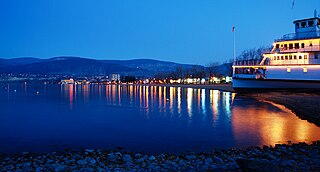
Penticton is a city in the Okanagan Valley of the Southern Interior of British Columbia, Canada, situated between Okanagan and Skaha lakes. In the 2016 Canadian Census, its population was 33,761, while its census agglomeration population was 43,432.

The Okanagan, also known as the Okanagan Valley and sometimes as the Okanagan Country, is a region in the Canadian province of British Columbia defined by the basin of Okanagan Lake and the Canadian portion of the Okanagan River. It is part of the Okanagan Country, extending into the United States as Okanogan County in north-central Washington. According to the 2016 Canadian census, the region's population is 362,258. The primary city is Kelowna.
Highway 3A is the designation of two segments of highway in the southern part of British Columbia.

Osoyoos is the southernmost town in the Okanagan Valley in British Columbia between Penticton and Omak. The town is 3.6 kilometres (2.2 mi) north of the United States border with Washington state and is adjacent to the Osoyoos Indian Reserve. The origin of the name Osoyoos was the word sẁiẁs meaning "narrowing of the waters" in the local Okanagan language (Syilx'tsn). The "O-" prefix is not indigenous in origin and was attached by settler-promoters wanting to harmonize the name with other place names beginning with O in the Okanagan region. There is one local newspaper, the Osoyoos Times.

Princeton is a town in the Similkameen region of southern British Columbia, Canada. It lies just east of the Cascade Mountains, which continue south into Washington, Oregon and California. The Tulameen and Similkameen Rivers converge here. At the 2016 census, the population was 2,828.
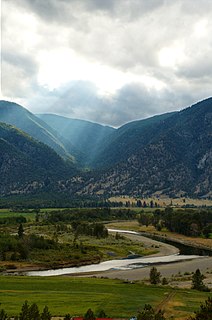
The Similkameen River runs through southern British Columbia, Canada, eventually discharging into the Okanagan River near Oroville, Washington, in the United States. The river is said to be named for an indigenous people called Similkameigh, meaning "treacherous waters".
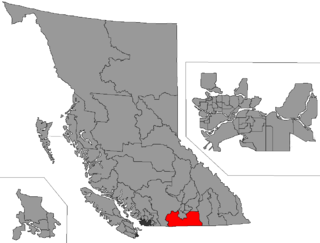
Boundary-Similkameen is a provincial riding formed in 2008. It includes the populations of Penticton-Okanagan Valley, West Kootenay-Boundary and Yale-Lillooet. The riding's name corresponds to that of a former riding in the same area, with similar but not identical boundaries.
Okanagan-Boundary was a provincial electoral district in the Canadian province of British Columbia spanning the area from the Similkameen towns of Kaleden and Keremeos to Grand Forks and Christina Lake, and including the southern Okanagan towns of Okanagan Falls, Oliver, Osoyoos, Rock Creek and Greenwood. The riding first appeared in the 1991 election as the result of a redistribution of the former riding of Boundary-Similkameen. The same area is now part of West Kootenay-Boundary.

Keremeos is a village in the Southern Interior of British Columbia, Canada. The name originated from the Similkameen dialect of the Okanagan language word "Keremeyeus" meaning "creek which cuts its way through the flats" referring to Keremeos Creek which flows down from the Upper Benchlands to the Similkameen River that runs by the village.

The Regional District of Okanagan-Similkameen (RDOS) is in southern British Columbia, adjacent to the U.S. state of Washington. It is bounded by Fraser Valley Regional District to the west, Thompson-Nicola Regional District and Regional District of Central Okanagan to the north, Regional District of Kootenay Boundary to the east, and by Okanogan County, Washington to the south. At the 2011 census the population was 80,742. The district covers a land area of 10,413.44 square kilometres (4,020.65 sq mi). The administrative offices are in the City of Penticton.
School District 53 Okanagan Similkameen is a school district that serves fragments of the southern Okanagan and lower Similkameen regions, which include Cawston, Hedley, Keremeos, Okanagan Falls, Oliver, and Osoyoos, totaling to six communities in the district, all of which are in British Columbia, Canada. Its main "maintenance department" office is held in Oliver, consisting of ten schools, five of which are elementary, three are high or secondary schools, while two are alternative schools. This district's superintendent is Beverly Young, while 2,665 students attend schools in it; there are 480 employees for the Okanagan Simlkammen school district. Their motto is "Learning Today for Living Tomorrow", and all places within the district are towns or villages.

The Syilx people, also known as the Okanagan or Okanogan people, are a First Nations and Native American people whose traditional territory spans the Canada–US boundary in Washington state and British Columbia in the Okanagan Country region. They are part of the Interior Salish ethnological and linguistic grouping. The Syilx are closely related to the Spokan, Sinixt, Nez Perce, Pend Oreille, Secwepemc and Nlaka'pamux peoples of the same Northwest Plateau region.
The Okanagan Nation Alliance is a First Nations Tribal Council in the Canadian province of British Columbia, spanning the Nicola, Okanagan and Similkameen Districts of the Canadian province of British Columbia and also the Colville Indian Reservation in Washington state of the United States of America.
Franz Xavier Richter, commonly known as Frank Richter, was a pioneer settler, miner and rancher in 19th century Washington and British Columbia.
The Similkameen Country, also referred to as the Similkameen Valley or Similkameen District, but generally referred to simply as The Similkameen or more archaically, Similkameen, is a region roughly coinciding with the basin of the river of the same name in the Southern Interior of British Columbia. The term "Similkameen District" also refers to the Similkameen Mining District, a defunct government administrative district, which geographically encompasses the same area, and in more casual terms may also refer to the Similkameen electoral district, which was combined with the Grand Forks-Greenwood riding by the time of the 1966 election. The Similkameen Country has deep historical connections to the Boundary Country and the two are sometimes considered one region, partly as a result of the name of the electoral district. It is also sometimes classed as being part of the Okanagan region, which results from shared regional district and other administrative boundaries and names. The term "Similkameen District" may also historically refer to the Similkameen Division Yale Land District, which also includes Osoyoos and the Boundary Country to Osoyoos' east.
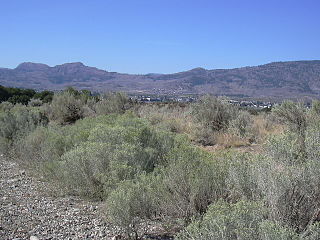
The Okanagan Desert is the common name for a semi-arid shrubland located in the southern region of the Okanagan Valley in British Columbia and Washington. It is centred around the city of Osoyoos and is the only semi-arid shrubland in Canada. Part of this ecosystem is referred to as the Nk'mip Desert by the Osoyoos Indian Band, though it is identical to the shrublands elsewhere in the region. To the northwest of this area lies an arid shrubland near Kamloops.

South Okanagan-Similkameen Transit provides local public, regional, and interregional transportation services in the City of Penticton in the Okanagan Valley of British Columbia, Canada, and outlying communities, with a fleet of fully accessible low floor transit buses. The system consists of six scheduled routes serving the city, and routes to outlying communities including Summerland, Naramata, Princeton, and Osoyoos.
Similkameen Elementary Secondary School is a part of School District 53 in the Similkameen Okanagan Valley. This school is a combined high school and elementary school, with about 300 students enrolled from grade five to twelve. Staff number approximately 40. Students attending this school are primarily from the surrounding towns of Keremeos, Cawston, Hedley, and Olalla.
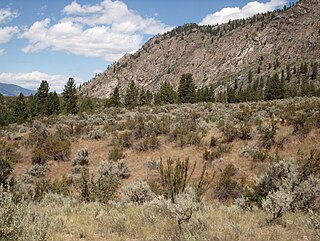
South Okanagan—Similkameen National Park Reserve is a proposed national park reserve located in the Regional District of Okanagan-Similkameen of British Columbia. The goal of the park is to work with the local First Nations to protect a large patch of Okanagan dry forests and part of the northern reach of the Columbia Plateau ecoregion in Canada.













